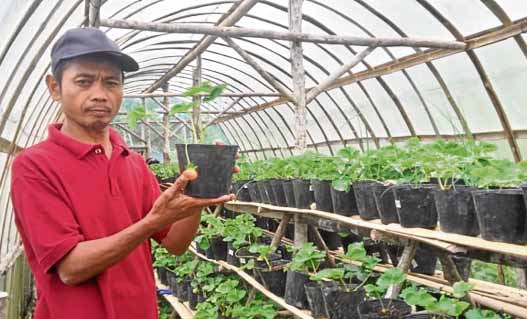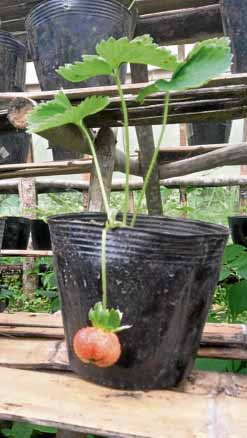Sweeter strawberries from Bohol

ROMY Bag-o, a member of the indigenous Eskaya tribe, grows strawberries in the mountain areas of Taytay in Duero town, in Bohol province.
Photos by Leo Udtohan, Inquirer Visayas
DUERO, Bohol—Strawberries from Bohol? Yes, Bohol.
Unknown to many, a tribe in the island-province is growing sweet and succulent strawberries in the mountain village of Taytay, 11 kilometers from the town center of Duero. Those who have tasted the berries attest that the Bohol variety is sweeter than those grown in Benguet and cheaper than those imported from the United States or Australia and sold in supermarkets in the capital city of Tagbilaran.
The Eskaya people have been cultivating the fruit crop in at least 200 pots inside two greenhouses. The project provides income to 622 tribal members who have organized themselves into a group called Taytay Lumad Multi-Purpose Cooperative.
The fruits harvested are sold for P200 to P300 per kilogram.
Pioneer
Romy Bag-o, 54, who runs the farm in Taytay, pioneered strawberry growing in the village in 1987. He started with five seedlings in his backyard after his friend, Ronilo Sarong, introduced him to it. At that time, he and the other tribe members were growing vegetables like cabbage, pechay, and onions.
After a month, the strawberry plants matured and yielded a total of 10 kilograms of fruits.
Bag-o had planned to keep the strawberries for his family’s consumption, but neighbors pleaded to buy some. Seeing the chance to earn, he sold the harvest for P200 per kg.
Eventually, Bag-o planted 2,000 seedlings in his half-hectare farm.
The strawberry fields attracted locals and tourists who visited the tribe, who are known for their production of sinamay (fibers made from abaca that are handwoven into barong).
Success story
Although Bag-o had no formal training on cultivating strawberries, his farm was a success. His wife, Jemma, 47, and their three children—Amelito, 26, Anabelle, 30, and Archie, 12—help him manage the farm.
“The berries bear fruit immediately. We usually harvest every other day. They are also easy to sell. We don’t have to look for buyers because the tourists come here,” Bag-o says. He harvests three to five kg a day during fruiting and sells these to tourists for P200 to P300 per kg.
In 1996, Bag-o ordered 25,000 seedlings from Benguet, but these went to waste after a fungus attack. He went back to growing the usual vegetable crops.
In 2014, the Eskaya members decided to form a cooperative and look for ways to augment their income from farming. They recalled how Bag-o made money from his backyard strawberry enterprise.
Ideal farm site
Their elders decided to try growing strawberries, which are not common in Bohol but had a big economic potential. The temperature in Barangay Taytay is also ideal for plant growth, going up to as high as 24 degrees Celsius during the day and dropping to close to 15 degrees at night.
Fog usually shrouds the village in the early morning and at dusk.
The cooperative hired Bag-o to run the farm on a salary of P200 per day since he is the only one among tribe members who has had an experience in strawberry farming.
Early in the morning, Bag-o checks the pots and waters the berries. “You have to always tend to the strawberries because they need extra care,” he said.
He described his work as challenging. Changes in weather, like a sudden downpour, can destroy the plants. Sometimes, the fruits are too small and deformed, and vulnerable to diseases and pests, particularly rats.
The ideal months to grow strawberries are November and December. In March and April, the plants start to bear fruits.
Healthy treat
Health-conscious individuals believe that strawberries are refreshing and healthy treats.
According to the Mayo Clinic website, strawberries are an excellent source of Vitamins C and fiber, potassium, and magnesium. Research studies say strawberries help fight cancer and heart diseases, promote eye health, and reduce joint inflammation.
Bag-o’s story has inspired other residents who began building strawberry gardens in Barangay Bangwalog in Duero town, Mayana in Jagna town, and even in Sierra-Bullones town. Some grow the plants in pots and bamboo receptacles filled with rice stalks.
Bag-o hopes to visit Baguio City someday to observe strawberry farming and gain lessons that he can apply on his farm.
After all, Taytay has the potential to become the strawberry basket of the Visayas, he says.

